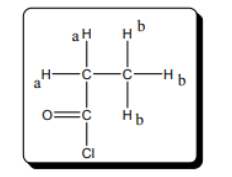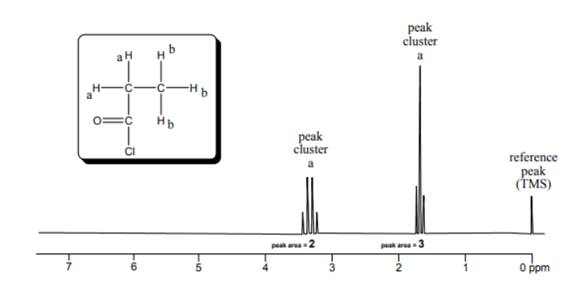
Concept explainers
Interpretation:
The number of chemically distinct protons in the given molecule should be predicted.

Concept Introduction:
NMR stands for nuclear magnetic resonance. A given compound contains different types of H-signals due to the presence of different magnetic environment within a molecule.
The number of signals obtained by the proton can be determined by spitting rule (n + 1), where n represents the number of the adjacent protons.
Answer to Problem 1CTQ
The number of chemically distinct proton in given molecule is 2.
Explanation of Solution
The protons present in the same environment are known as chemically equivalent protons. The number of chemically equivalent protons present in a molecule tells the number of peak obtained in the spectra for given molecule. The NMR spectra of the given molecule is represented as follows:

The triplet in the spectra represents that it has two neighbouring protons which means the triplet is representing protons a. on the other hand, the quartet means it has three neighbouring protons thus, representing the methyl group. As the number of peaks in the spectra is 2, that means two different chemically equivalent protons are present in the given molecule.
Thus, there are two chemically distinct protons in the model .
Want to see more full solutions like this?
Chapter L4 Solutions
Custom eBook for Organic Chemistry
- presented by Morallen Lig Intermine the hand product for the given mution by adding atoms, bonds, nonhonding diarion panda скуль Step 3: Comp the draw the product Step 2: Agama workup Compithe 429 ملولةarrow_forwardReaction A 0,0arrow_forwardpresented by Morillon Leaning Predict the organic product for the min кусур HSC Adithane carved arnown to come than that to the condon slchroruis in acid in in aquishri with ноюarrow_forward
- 6.15PM Sun Mar 30 K Draw the major product of this reaction. Include any relevant stereochemistry. Ignore inorganic byproducts. Problem 1 of O H [PhзPCH2CH3]*C|¯ NaH Drawing > Q Atoms, Bonds and Draw or tap a nearrow_forward8:17 PM Sun Mar 30 Draw the major product of this reaction. Ignore inorganic byproducts. HSCH2CH2CH2SH, BF3 Probler Drawing Ato Bonds Clarrow_forwardpresented by Mr L How the coprion. (Il Done in no wraction, dew the starting redential) доarrow_forward
- 8:16 PM Sun Mar 30 K Draw the major product of this reaction. Ignore inorganic byproducts. Proble 1. CH3MgBr 2. H3O+ F Drawingarrow_forwardо но оarrow_forwardName the major organic product of the following action of 4-chloro-4-methyl-1-pentanol in neutral pollution 10+ Now the product. The product has a molecular formula f b. In a singly hain, the starting, material again converts into a secule with the molecular kormula CIO. but with comply Draw the major organic structure inhalationarrow_forward
- Macmillan Learning Alcohols can be oxidized by chromic acid derivatives. One such reagent is pyridinium chlorochromate, (C,H,NH*)(CICTO3), commonly known as PCC. Draw the proposed (neutral) intermediate and the organic product in the oxidation of 1-butanol by PCC when carried out in an anhydrous solvent such as CH₂C₁₂. PCC Intermediate OH CH2Cl2 Draw the intermediate. Select Draw Templates More с H Cr о Product Draw the product. Erase Select Draw Templates More H о Erasearrow_forwardIf I have 1-bromopropene, to obtain compound A, I have to add NaOH and another compound. Indicate which compound that would be. A C6H5 CH3arrow_forwardProvide the reagents for the following reactions.arrow_forward
 Organic Chemistry: A Guided InquiryChemistryISBN:9780618974122Author:Andrei StraumanisPublisher:Cengage Learning
Organic Chemistry: A Guided InquiryChemistryISBN:9780618974122Author:Andrei StraumanisPublisher:Cengage Learning
